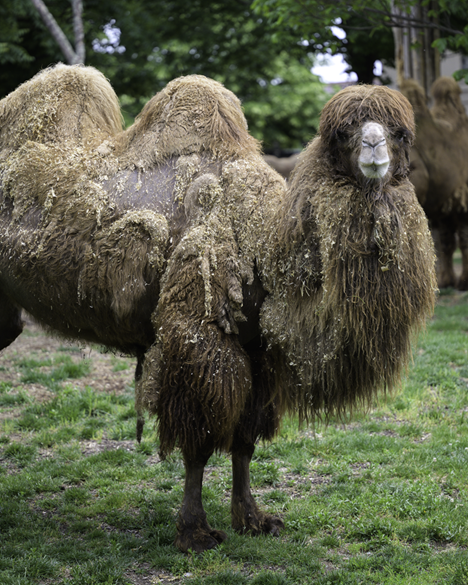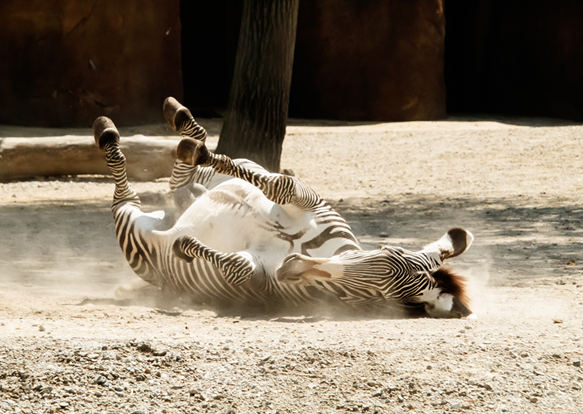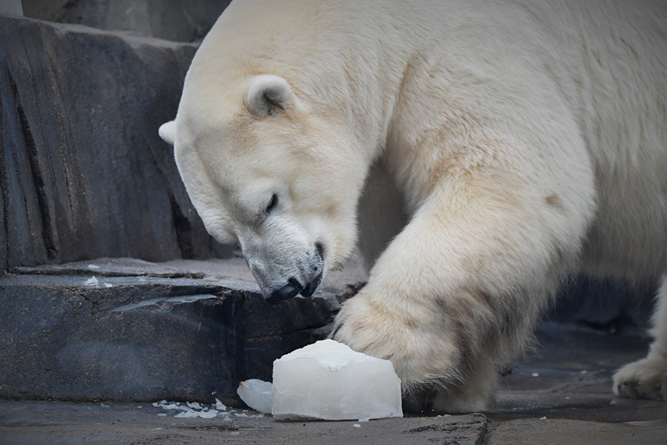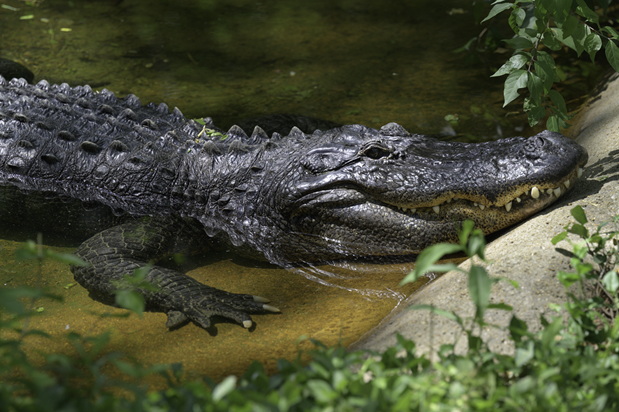Author: Kim Hoormann, Manager of Learning Experiences
Photos by Ray Meibaum, Danny Recklein, JoEllen Toler and Robin Winkelman
This article was originally published in the Summer 2023 edition of STLZoo Magazine. Become a Zoo member to subscribe to the print magazine at https://stlzoo.org/membership.
As any St. Louisan knows, our summer heat (and humidity) can be intense! We are often asked how the animals that call the Zoo home deal with the extreme temperatures. Many animals have natural adaptations that help them, plus our entire Zoo team is dedicated to providing excellent care to keep them healthy and comfortable. A lot of what the animals and keepers do are very similar to how we survive the summer!
CHANGING CLOTHES
Just like we change our clothes to adapt to the seasons, animals do something similar. They aren’t shuffling their tubs of winter coats, hats and gloves to storage and pulling out the shorts and T-shirts! Rather, they are losing their thick winter “coats.” If you have ever taken a good look at our camels in spring or summer, they look a little shaggy because they are losing their thick fur, which kept them warm over the winter. While it might look like they’re having a really bad hair day, it’s a natural process and doesn’t hurt at all. Many mammals naturally lose fur as the weather warms.

SUN PROTECTION
If you are coming to visit the Zoo, or going anywhere sunny, you need to have your sunscreen on so you don’t get a sunburn. Animals also use sunscreen, but not in the same way we do. Hippos secrete a pink slime called “blood sweat” (even though it’s neither blood nor sweat) that scientists believe acts like sunscreen to protect their skin. Rhinos roll in mud to protect their skin from sunburn, so our keepers always make sure they have muddy wallows to enjoy — plus it’s fun for the animals! Other animals like zebras or Somali wild asses might roll in dirt to add a layer of physical protection to their bodies, much like some people may wear long-sleeve sun shirts. Plus, those layers help protect from bug bites! Shade structures in animal habitats also provide protection from the sun.

DIET CHANGES
While many people enjoy a bowl of warm soup or chili on a cold winter’s day, it isn’t quite as enjoyable on a hot summer evening. Similar to how we change our eating habits and diets as the weather changes, animals do, too! For example, our grizzly bears receive fish, chow, meat and produce (fruits and vegetables) year-round. But, based upon the bears’ appetites and behaviors, the carnivore team may cut back or potentially increase the amount of food they offer to the bears. We see that the bears’ appetites change seasonally.

COOL FUN
What are some of your favorite things to do in the summer? Play in a pool, perhaps? Enjoy a frozen treat or slice of frozen watermelon? Zoo animals enjoy these same things! As you explore the Zoo, you will see that many animals have pools in their habitats. For example, our American alligator will often fully submerge himself; look carefully for his eyes and nostrils in the water! Water in animal habitats can be chilled, as needed, for the species-specific needs. For example, Humboldt penguins naturally live along the coast of Chile and Peru where the temperature on land can be very warm, routinely exceeding 90 degrees Fahrenheit. But the Humboldt Current in that region brings cold ocean water to those coasts, providing the animals that live there a way to beat the heat. We do the same thing at the Zoo with the outdoor Humboldt penguins. Even on hot outdoor days, their water is a chilly and refreshing 45 to 55 degrees Fahrenheit. Animals that don’t swim may have water misters in their habitats, if appropriate for the animals’ needs, to help them stay cool and refreshed. Care teams also provide frozen treats to the animals. Many animals receive sugar-free ice pops, sometimes stuffed with yummy food that is part of their diet. The sea lion ice pops might have squid or fish in them, while the apes could find apples in their frozen treats! For carnivores (natural meat eaters), they might receive what is affectionately called a “blood-sicle.” It might sound gross to us, but it’s one way we keep our carnivores healthy.

CHOICE AND CONTROL
An important part of animal care and well-being is offering the animals choice and control in their environment. Ectothermic (cold-blooded) animals — like reptiles whose body temperature is dependent upon their environment — will seek out pools of water, find shade, or dig burrows underground in order to bring their body temperatures down. Endothermic (warm-blooded) animals — like mammals and birds whose internal body temperature is constant — also seek out places and opportunities for comfort. The Zoo teams make sure to provide these opportunities to all animals. In addition to public-facing habitats, many animals also have habitats that are behind the scenes. Similar to how they may choose to stand in the shade, sit in front of a water mister or soak in a pool, animals may choose to go inside on hot summer days. Animals have this option year-round, so if you are visiting the Zoo and don’t see animals in their habitats, it might be because they have chosen to be inside at that time.
WE CARE ABOUT PEOPLE, TOO
Not only is the Zoo committed to caring for animals, but we want people to stay healthy in the heat, too. Things like wearing sunscreen, hats and sunglasses help provide sun protection. Staying hydrated is key for our Zoo employees and guests! Reusable water bottles can be filled up at water fountains or bottle filling stations and should be used frequently. Zoo employees who work outside may adjust their routines and
responsibilities so they can avoid being outside (as much as possible) during the hottest part of the day. While we hope that everyone is making smart choices to be safe in the heat, in the event of a heat-related health emergency, the Zoo has team members trained in first aid and can call the on-grounds medics if needed.
We hope to see you at the Zoo this summer! Be sure to visit some of these animals and see if they’re demonstrating any of their natural behaviors to stay cool!

